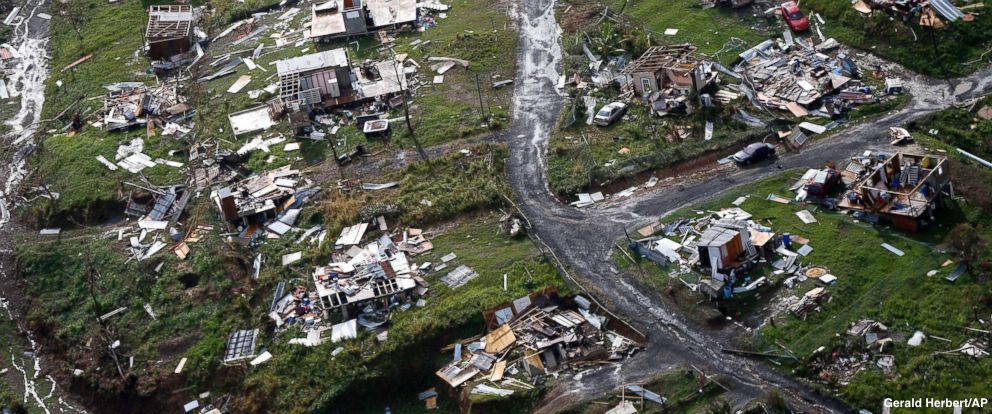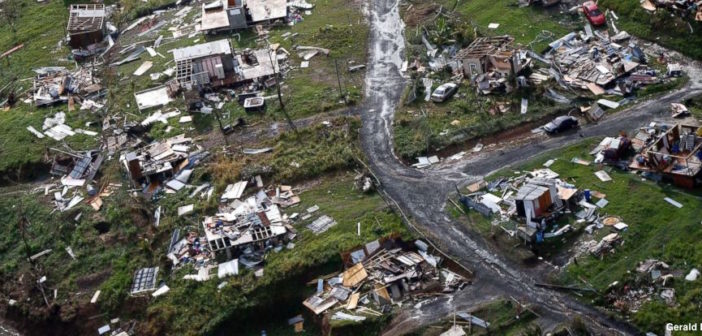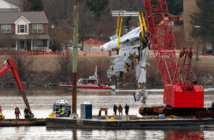
The Puerto Rico’s governor ordered a review of the death toll following Maria, since many sources claim that the death toll is much higher than the reported number.
Credit:@ABC
With Hurricanes Irma and Maria wreaking havoc on Puerto Rico, leaving much of the island still without power and increasing the spotlight on Puerto Rico’s debt, there are many questions of how the struggling country will dig themselves out of the hole and how will the power and other social issues in the aftermath of the storms be solved.
The country is reportedly about $74 billion in debt and financial troubles were already affecting Puerto Rico way before the storms hit, as the territory has been in economic recession for several years now. In fact, Puerto Rico filed for municipal bankruptcy in May. According to CNN, it was “biggest U.S. municipal bankruptcy in history.”
President Trump has indicated his desire to lend a hand to Puerto Rico. During an interview with Gerald Rivera from Fox News, Trump indicated that he plans to wipe out the debt.
“We’re going to help the people. Look… This had a lot of problems and a lot of debt. They had 72 billion dollars in debt before the hurricanes hit and they had a power plant that didn’t work before the hurricanes. So, we’re going to help them. We’re going to do something, and we’re going get it back on its feet,” said Trump. “We’re going to work something out. We have to look at their whole debt structure. You know they owe a lot of money to your friends on Wall Street, and we going to have to wipe that out.”
There are many people who decide to look at the human side of the issue, including Dr. Douglas Astolfi, professor of history at Saint Leo University, who mentioned this massive debt the island is burdened with.
“Very recently, Puerto Rican debt, which has always been sort of absorbed into the federal debt, became standalone debt that Puerto Rico is now responsible for. And it’s a huge debt per capita basis. It’s a huge debt if we think about how much it would cost each individual Puerto Rican in Puerto Rico to pay of that debt. It becomes an impossible burden,” said Astolfi.
Astolfi suggested that a way to help Puerto Rico is to absorb the debt, like Trump vowed.
“One of the things they can do is absorb the debt and recognize that the fact the debt largely comes about because of the need of things in Puerto Rico that perhaps should have been paid for by the Federal Government, since Puerto Rico doesn’t have a voice in the federal government,” said Astolfi. “I also think you could just forgive the debt at this point; we done that before we did it as early as 1788 when we’re passing the constitution; we forgave all the debts of all the states. So, there are precedents that allows us to do that.”
However, it may not be so simple to wipe out the debt. There has to be consideration for the debtholders because wiping the debt affects them. And contrary to popular belief, most of the debt is not from those on Wall Street. In fact, CNN reports that less than 25 percent is held by hedge funds.
“In total, bond mutual funds hold about $11.3 billion of the island’s debt. Another roughly $15 billion is held by hedge funds. The remainder of the debt is held largely by individuals — mostly Puerto Ricans and mainland Americans,” according to CNN.
So, wiping out the debt may be difficult since it is not only hedge funds suffering losses, but many regular Americans would be at risk.
There would be other issues with wiping out Puerto Rico’s large debt. In fact, Dr. Lucia Farriss, instructor of economics at Saint Leo University, explained the economic effects of this, explaining that there would be two major problems.
“The problem with wiping out debt is two-fold: it erodes investor confidence in future dealings with the borrower (i.e. PR government). Remember that there are two parties involved in bonds issues: the borrower and the lender. If the borrower defaults, the lender becomes very wary of lending to it the next time. The government may not be able to raise funds in the future without offering a high-risk premium,” said Farriss. “The second problem is that it has the same effect as a bail-out: the party receiving the bailout may come to expect that same treatment anytime it gets into trouble, rather than avoid the mistakes that took it down that path in the first place. This is a clear example of moral hazard.”
Completing wiping the debt is not the best financial solution and this is evident because, despite Trump’s vow to wipe the debt in Oct., his administration does not seem to support him. According to the New York Times, days following Trumps’ proposal, his Director of the Office of Management and Budget, Mick Mulvaney, dismissed Trump’s indication of wiping out the debt and also stated to CNN that the administration would focus on rebuilding efforts. However, Mulvaney said that “Puerto Rico is going to have to figure out how to fix the errors that it’s made for the last generation on its own finances.”
Despite Mulvaney’s claims that Puerto Rico will figure it out, Puerto Rico is still desperate over two months following the hurricanes. In fact, according to The Washington Post, in December, “there is no capacity for any debt payments in the coming decade, and the entire debt stock will need to be massively written-down to make the island’s recovery feasible.” Therefore, Puerto Rico is still suffering from the effects of the hurricane and is not able to handle this debt as they once were, as Mulvaney suggested back in Oct.
Puerto Rico had trouble paying its debt in the past several years during it recession, and the situation has exacerbated with the hit of hurricanes. Farriss offered an economic solution for Puerto Rico.
“PR is already at a point of no return. The only working solution is to reach an agreement with bondholders. Losing the confidence of your lenders is not wise, and the best road forward will come from restructuring the debt with a little give and take from all sides: the government of PR, the government of the U.S., and bondholders,” said Farriss. “I also believe that the solution should rest on an agreement to not only enact economic reforms on the island, but also to institute credible oversight procedures moving forward.”
Nevertheless, there are a lot of hoops that Puerto Rico has to jump through because major economic decisions, like absolving debt or restructuring debts, has to go through approval from the U.S. Government. So, these types of decision have to be approved by Congress, and it seems difficult already because there is more consideration for states rather than territories, as Instructor of Political Science Mr. Francis Orlando mentioned. When asked about this, Orlando mentioned that Puerto Rico has some disadvantages for being a territory rather than a state.
“Puerto Ricans are citizens, but they voted against becoming a state for a long time. That means you have some more independence,” said Orlando. “But on the other hand, there are the negatives that you just aren’t going to get as much support but that doesn’t mean that isn’t something that can change for the territory like Congress can easily pass something that allowing territory to do that, but they decided not do something.”
Orlando mentioned that Republicans are less likely to bail out and democrats are more likely to do so. Nevertheless, there aren’t many cases of states that needed to be bailed out due to massive debt. Orlando stated that cities and towns are more likely to declare bankruptcy, mentioning that Detroit and some cities in California have done so.
“States haven’t done that fortunately because none of them have been in that rough of shape. Puerto Rico, unfortunately for them, is in far worse shape than other state has been, and they were in it before and now it’s way worse,” said Orlando. “They can almost unilaterally push for Congress to absolve their debt. That would be an unprecedented step; President Trump already called for it and even Elizabeth Warren, the other day, called for it. That would at least allow them to kin of dig out of the hole they are in. Once that debt is relieved they are going to be able spend money on fixing infrastructure.”
Overall, Puerto Rico is in major debt, and is suffering, and this is partly due to Puerto Rico being a territory and their dependence on United States, to learn more about how Puerto Rico got in this deep debt, please read the following article: How Puerto Rico Got Into $74 Billion of Debt – History of Puerto Rico’s Economic Downfall.
For more information on how Puerto Rico being territory rather than state as made them suffered, in particular as this situation has not allowed them to get funding as quickly as other states in the case of hurricane relief efforts, please read the following article: Treatment of Puerto Rico As A Territory In Aftermath Of Hurricanes.





